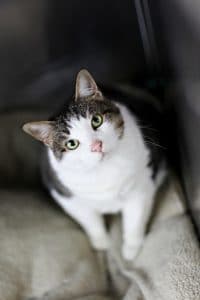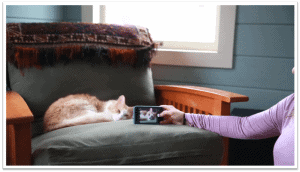
Getting photos of foster pets can feel hard – sometimes lighting in our home isn’t the best or our foster has the case of the wiggles. And sometimes a pet can be camera shy. But thankfully a few small adjustments and the use of a handy cell phone can make a world of difference.
In the life of a busy foster parent – balancing your job, family, your own pets, and your new foster-addition – we sometimes overlook the value of sending the shelter or rescue photos + video of our fosters. But especially now, with major changes to everyday life and shelters placing more animals than ever into foster because of COVID-19, the content that you can share as a foster means everything! And images – whether photos or videos – and your feedback on fosters is where the real magic comes in! Animal welfare orgs have a hard time promoting pets without up to date images or videos, especially in fast-paced social media feeds.
The good news is, snapping photos of your foster doesn’t need to be stressful or no-fun. It can be a wonderfully rewarding component of helping your foster capture someone’s heart – and finding a permanent home! Here are our top 10 tips for getting better photos of pets in foster.
![]() #1 Use Natural Light Whenever Possible If you’re shooting indoors, position your subject with a large window behind YOU (not behind the animal, which creates backlighting). This will illuminate the details of their facial features; something poorly lit areas will quickly relegate to unflattering, especially for darker animals. Choose a room that has diffused light and is bright, but not in direct sunlight. If you’re outdoors, wait until the sun goes behind a cloud or find a patch of shade for the most flattering photos.
#1 Use Natural Light Whenever Possible If you’re shooting indoors, position your subject with a large window behind YOU (not behind the animal, which creates backlighting). This will illuminate the details of their facial features; something poorly lit areas will quickly relegate to unflattering, especially for darker animals. Choose a room that has diffused light and is bright, but not in direct sunlight. If you’re outdoors, wait until the sun goes behind a cloud or find a patch of shade for the most flattering photos.
![]()
#2 Don’t Use Flash and Stay Out of the Sun While light is the most important component of a good photo, unflattering light such as a flash (glowing eyes or overexposed wrinkles – no way!) or direct sunlight (again, way too bright and unflattering – if you have to squint, so will your shelter pet) result in images that don’t typically work.
![]() #3 Clear the Clutter Taking a moment to look at what surrounds the animal, both in the immediate area or the background, and either clearing the space momentarily or repositioning yourself for a better background, makes a huge difference. Our eyes naturally do this, but in a photo all the minutia of the background tends to distract. Pay special attention to things like: litter pans, dirt, laundry, or just general debris.
#3 Clear the Clutter Taking a moment to look at what surrounds the animal, both in the immediate area or the background, and either clearing the space momentarily or repositioning yourself for a better background, makes a huge difference. Our eyes naturally do this, but in a photo all the minutia of the background tends to distract. Pay special attention to things like: litter pans, dirt, laundry, or just general debris.
![]() #4 Shoot for Eye Contact For foster pets, eyes are the window to adoption! Get their attention towards your camera with apps like Pup Pic, a quick kissy-noise, our favorite cat toy for photography, the Cat Dancer, or sometimes even crinkling a wrapper, foil ball, or treat bag! The golden rule of grabbing their attention is not to overstimulate – for instance, if you know your foster is highly treat-motivated, you actually don’t want to use food to get their attention because they’ll ultimately look too intense or won’t stay still – it’s just too much excitement. Instead, when you have framed your shot and are ready to press the shutter, use a subtle noise or lure that attracts attention but doesn’t entice them to get up and walk towards you or leap through the air!
#4 Shoot for Eye Contact For foster pets, eyes are the window to adoption! Get their attention towards your camera with apps like Pup Pic, a quick kissy-noise, our favorite cat toy for photography, the Cat Dancer, or sometimes even crinkling a wrapper, foil ball, or treat bag! The golden rule of grabbing their attention is not to overstimulate – for instance, if you know your foster is highly treat-motivated, you actually don’t want to use food to get their attention because they’ll ultimately look too intense or won’t stay still – it’s just too much excitement. Instead, when you have framed your shot and are ready to press the shutter, use a subtle noise or lure that attracts attention but doesn’t entice them to get up and walk towards you or leap through the air!

-
- Get Low Or at least at eye level. This may require some creative photo taking but keep in mind two tips that can help when using a cell phone: 1) On iPhone, your headphone volume button can act as the shutter button, which can help you steady the phone with one hand and easily snap a photo using the headphones with the other. 2) On all cell phones, when holding horizontally, one of the volume buttons will double as a shutter – so rather than tapping on the screen and potentially getting a blurry photo, try this out.
- Or Elevate the Pet For cats, kittens, and dogs allowed on the furniture, let them get comfy on a blanket or bed or some other natural position and then sit on the floor in front of them for perfectly on-their-level photos.
- Avoid the Common Mistakes It’s tempting to snap a shot of a dog as you’re walking or a cat at feeding time – sometimes it completely escapes our busy minds to photograph our foster pets until one of these moments – but photos from above or pets moving around too much can be misleading in terms of size, can end up being blurry, and often aren’t able to be used to effectively promote the pet. In these moments, take a video instead!
![]() #5 Don’t be Afraid to Include People Having a person’s hand, feet, or even an unobtrusive lap in the photo can help define the size of your foster, while also showing connection that helps potential adopters imagine life with that pet. Just stick to images that you’d happily place on the internet (no shirtless boyfriends or embarrassing photos of the kids!) if allowing someone to be in the photo – and think about what allows the pet to still remain the center of attention.
#5 Don’t be Afraid to Include People Having a person’s hand, feet, or even an unobtrusive lap in the photo can help define the size of your foster, while also showing connection that helps potential adopters imagine life with that pet. Just stick to images that you’d happily place on the internet (no shirtless boyfriends or embarrassing photos of the kids!) if allowing someone to be in the photo – and think about what allows the pet to still remain the center of attention.
-
- Bend a Rule This is also where it’s ok to break the eye-contact rule – an animal with eyes close or deep into a cuddle sesh can be just as beautifully connective as a photo with direct eye contact.

![]() #6 Focus on Focusing Gain more control over the exposure of your image by using the focus and exposure lock function. Just tap the screen where your subject is to lock your focus (a little yellow icon will show up on your screen to indicate lock on iPhone and a green box or white box on many Android phones indicates the same thing). On most phones tapping on the screen also gives you control over exposure, so that a slider with plus and minus pops up and allows you to adjust how bright or dark the image is going to be. This is especially useful when your subject is much darker than the background.
#6 Focus on Focusing Gain more control over the exposure of your image by using the focus and exposure lock function. Just tap the screen where your subject is to lock your focus (a little yellow icon will show up on your screen to indicate lock on iPhone and a green box or white box on many Android phones indicates the same thing). On most phones tapping on the screen also gives you control over exposure, so that a slider with plus and minus pops up and allows you to adjust how bright or dark the image is going to be. This is especially useful when your subject is much darker than the background.
![]() #7 Don’t Pinch Your Pixels Use your feet to zoom by moving closer to your subject as opposed to using the zoom function on your phone. Because it is a digital zoom rather than an optical zoom, pinching and zooming will reduce the quality of the image because it actually reduces pixels. This leads to grainy photos that often are too blurry or pixelated to use online.
#7 Don’t Pinch Your Pixels Use your feet to zoom by moving closer to your subject as opposed to using the zoom function on your phone. Because it is a digital zoom rather than an optical zoom, pinching and zooming will reduce the quality of the image because it actually reduces pixels. This leads to grainy photos that often are too blurry or pixelated to use online.

![]() #8 Use your Cell Phone’s Powers Today’s cell phones have some amazing features that we forget to take advantage of – like portrait mode! This nicely blurs the background and reduces distractions. Try to frame the shot so that the pet’s face fills most of the photo, rather than having too much negative space, when using portrait mode. If your phone has a ‘pro’ or ‘manual’ mode, use it so that you can adjust exposure and focus, and ultimately have more control over the quality of your shot.
#8 Use your Cell Phone’s Powers Today’s cell phones have some amazing features that we forget to take advantage of – like portrait mode! This nicely blurs the background and reduces distractions. Try to frame the shot so that the pet’s face fills most of the photo, rather than having too much negative space, when using portrait mode. If your phone has a ‘pro’ or ‘manual’ mode, use it so that you can adjust exposure and focus, and ultimately have more control over the quality of your shot.
![]() #9 Blur that Background! The other method for controlling depth of field is changing the distance of your subject from the lens. For example, the closer your subject is to your lens (and with your focus set on that subject), the shallower your depth of field will become. And vice versa, the further away your subject is from your camera, the more will be in focus around them.
#9 Blur that Background! The other method for controlling depth of field is changing the distance of your subject from the lens. For example, the closer your subject is to your lens (and with your focus set on that subject), the shallower your depth of field will become. And vice versa, the further away your subject is from your camera, the more will be in focus around them.
![]() #10 The Most Important Rule of All: Make it a Positive Experience Has this ever happened to you? A family member wants to take a photo of you. They ask you to strike a pose, then everyone gets quiet (too quiet), and it seems like it takes FOREVER for them to actually take the photo? In those few seconds of painful silence, you feel your face cramp and you may even get a little nervous.
#10 The Most Important Rule of All: Make it a Positive Experience Has this ever happened to you? A family member wants to take a photo of you. They ask you to strike a pose, then everyone gets quiet (too quiet), and it seems like it takes FOREVER for them to actually take the photo? In those few seconds of painful silence, you feel your face cramp and you may even get a little nervous.
 But, have you ever posed for a photo while you’re giggling and chatting with the photographer the entire time? You almost forget the picture is being taken, and the photo turns out just as good — maybe better? Sure, it may take a few extra shots to get the perfect photo, but it was a much more pleasurable experience, right?
But, have you ever posed for a photo while you’re giggling and chatting with the photographer the entire time? You almost forget the picture is being taken, and the photo turns out just as good — maybe better? Sure, it may take a few extra shots to get the perfect photo, but it was a much more pleasurable experience, right?
This method works just as well with pets. While you don’t want the animal all riled up, speaking softly and gently to the animal throughout, reinforcing calm, happy behavior with treats or toys, and moving at a steady pace keeps the animal relaxed while still engaged. You can still make noises and squeak toys to achieve the expression you may need if they like that stimulant, but keeping them relaxed yet engaged between photos helps make the process go by much smoother.
Want more? Additional resources for making your foster pet shine:
Watch this video on Framing Your Shot!
<—-Snag this awesome infographic, created by KC Pet Project‘s Katie Grissum
Download our Cell Phone Photography Guide for quick reference
Take a peek at this video on 7 Photo Tips from Humane Rescue Alliance!
Read up on How to Get Great Photos ANYWHERE!
Follow our Take Great Photos board on Pinterest
Another oldie but goodie: This blog from 2018!
Kitten Lady’s video on How to Take Photos of Kittens: Cell Phone Edition
Learn more via Maddie’s Fund‘s Foster Caregiver Marketing Guide
Check out the photo tips we provided for Animal Farm Foundation‘s Marketing E-book
Take 15 mins and watch this video by Artists Helping Animals member, Monique Renee
BONUS: Check out this FREE webinar on Writing Pet Bios + Positive Marketing for Shelter Pets
Looking for editing apps? Check out:
Our Top Pick: Snapseed
Honorable mention – design app: Canva



